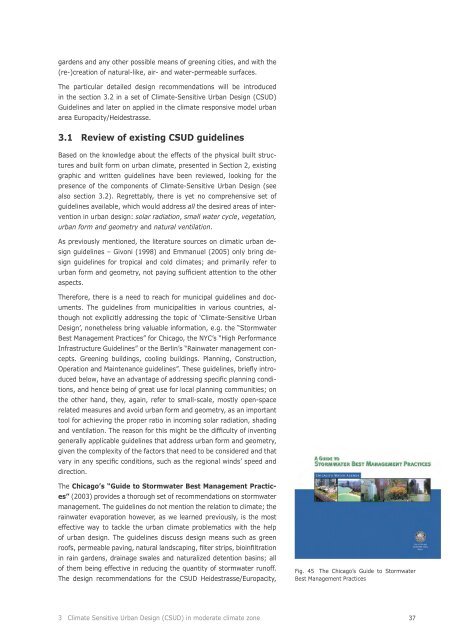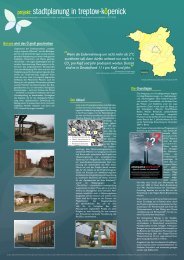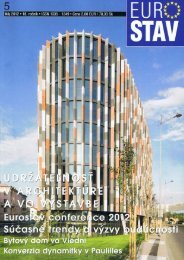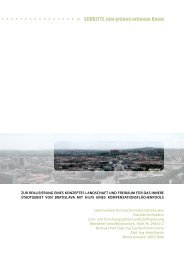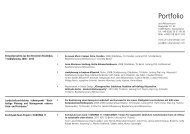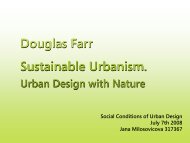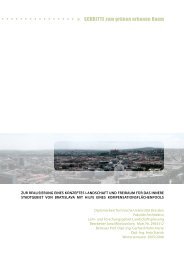Thesis document - Jana Milosovicova - Urban Design English
Thesis document - Jana Milosovicova - Urban Design English
Thesis document - Jana Milosovicova - Urban Design English
- No tags were found...
You also want an ePaper? Increase the reach of your titles
YUMPU automatically turns print PDFs into web optimized ePapers that Google loves.
gardens and any other possible means of greening cities, and with the(re-)creation of natural-like, air- and water-permeable surfaces.The particular detailed design recommendations will be introducedin the section 3.2 in a set of Climate-Sensitive <strong>Urban</strong> <strong>Design</strong> (CSUD)Guidelines and later on applied in the climate responsive model urbanarea Europacity/Heidestrasse.3.1 Review of existing CSUD guidelinesBased on the knowledge about the effects of the physical built structuresand built form on urban climate, presented in Section 2, existinggraphic and written guidelines have been reviewed, looking for thepresence of the components of Climate-Sensitive <strong>Urban</strong> <strong>Design</strong> (seealso section 3.2). Regrettably, there is yet no comprehensive set ofguidelines available, which would address all the desired areas of interventionin urban design: solar radiation, small water cycle, vegetation,urban form and geometry and natural ventilation.As previously mentioned, the literature sources on climatic urban designguidelines – Givoni (1998) and Emmanuel (2005) only bring designguidelines for tropical and cold climates; and primarily refer tourban form and geometry, not paying sufficient attention to the otheraspects.Therefore, there is a need to reach for municipal guidelines and <strong>document</strong>s.The guidelines from municipalities in various countries, althoughnot explicitly addressing the topic of ‘Climate-Sensitive <strong>Urban</strong><strong>Design</strong>’, nonetheless bring valuable information, e.g. the “StormwaterBest Management Practices” for Chicago, the NYC’s “High PerformanceInfrastructure Guidelines” or the Berlin’s “Rainwater management concepts.Greening buildings, cooling buildings. Planning, Construction,Operation and Maintenance guidelines”. These guidelines, briefly introducedbelow, have an advantage of addressing specific planning conditions,and hence being of great use for local planning communities; onthe other hand, they, again, refer to small-scale, mostly open-spacerelated measures and avoid urban form and geometry, as an importanttool for achieving the proper ratio in incoming solar radiation, shadingand ventilation. The reason for this might be the difficulty of inventinggenerally applicable guidelines that address urban form and geometry,given the complexity of the factors that need to be considered and thatvary in any specific conditions, such as the regional winds’ speed anddirection.The Chicago’s “Guide to Stormwater Best Management Practices”(2003) provides a thorough set of recommendations on stormwatermanagement. The guidelines do not mention the relation to climate; therainwater evaporation however, as we learned previously, is the mosteffective way to tackle the urban climate problematics with the helpof urban design. The guidelines discuss design means such as greenroofs, permeable paving, natural landscaping, filter strips, bioinfiltrationin rain gardens, drainage swales and naturalized detention basins; allof them being effective in reducing the quantity of stormwater runoff.The design recommendations for the CSUD Heidestrasse/Europacity,Fig. 45 The Chicago’s Guide to StormwaterBest Management Practices3 Climate Sensitive <strong>Urban</strong> <strong>Design</strong> (CSUD) in moderate climate zone37


